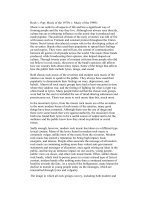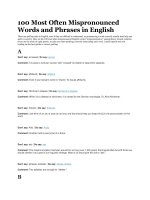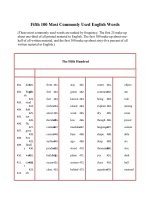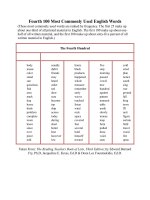The 100 Most Influential Music - Gini Gorlinski
Bạn đang xem bản rút gọn của tài liệu. Xem và tải ngay bản đầy đủ của tài liệu tại đây (4.41 MB, 362 trang )
Published in 2010 by Britannica Educational Publishing
(a trademark of Encyclopædia Britannica, Inc.)
in association with Rosen Educational Services, LLC
29 East 21st Street, New York, NY 10010.
Copyright © 2010 Encyclopædia Britannica, Inc. Britannica, Encyclopædia Britannica,
and the Thistle logo are registered trademarks of Encyclopædia Britannica, Inc. All
rights reserved.
Rosen Educational Services materials copyright © 2010 Rosen Educational Services, LLC.
All rights reserved.
Distributed exclusively by Rosen Educational Services.
For a listing of additional Britannica Educational Publishing titles, call toll free (800) 237-9932.
First Edition
Britannica Educational Publishing
Michael I. Levy: Executive Editor
Marilyn L. Barton: Senior Coordinator, Production Control
Steven Bosco: Director, Editorial Technologies
Lisa S. Braucher: Senior Producer and Data Editor
Yvette Charboneau: Senior Copy Editor
Kathy Nakamura: Manager, Media Acquisition
Gini Gorlinski, Associate Editor, Music and Dance
Diana Solomon, Copy Editor
Rosen Educational Services
Hope Lourie Killcoyne: Senior Editor and Project Manager
Nelson Sá: Art Director
Nicole Russo: Designer
Introduction by Chris Hayhurst
Library of Congress Cataloging-in-Publication Data
The 100 most influential musicians of all time / edited by Gini Gorlinski.
p. cm.—(The Britannica guide to the world’s most influential people)
“In association with Britannica Educational Publishing, Rosen Educational Services.”
Includes index.
ISBN 978-1-61530-056-3 (eBook)
1. Musicians—Biography. I. Gorlinski, Gini. II. Title: One hundred most influential
musicians of all time.
ML385A15 2010
780.92'2—dc22
[B]
2009029076
Cover credit: Carlos Spottorno/Photonica/Getty Images; p. 8 © www.istockphoto.com/Neil Sullivan;
p. 16 © www.istockphoto.com.
CONTENTS
Introduction
Guido d’Arezzo
Josquin des Prez
Antonio Vivaldi
George Frideric Handel
Johann Sebastian Bach
Joseph Haydn
Wolfgang Amadeus Mozart
Ludwig van Beethoven
Franz Schubert
Felix Mendelssohn
Frédéric Chopin
Franz Liszt
Richard Wagner
Giuseppe Verdi
Johannes Brahms
Sir W. S. Gilbert and
Sir Arthur Sullivan
Pyotr Ilyich Tchaikovsky
Giacomo Puccini
Gustav Mahler
Claude Debussy
Sergey Rachmaninoff
W. C. Handy
Arnold Schoenberg
Charles Ives
Béla Bartók
Igor Stravinsky
Leadbelly
Carter Family
Sergey Prokofiev
Cole Porter
Jimmie Rodgers
Fletcher Henderson
Bessie Smith
George Gershwin
8
17
18
20
23
29
38
43
52
58
64
69
74
80
85
90
97
100
106
110
117
121
125
126
132
134
138
145
146
149
155
158
160
162
163
44
91
148
Duke Ellington
Kurt Weill
Aaron Copland
Louis Armstrong
Umm Kulthūm
Count Basie
Dmitry Shostakovich
Bill Monroe
Mahalia Jackson
Robert Johnson
Woody Guthrie
John Cage
Muddy Waters
Billie Holiday
Frank Sinatra
Edith Piaf
Nat King Cole
Ella Fitzgerald
Leonard Bernstein
Pete Seeger
Ravi Shankar
Charlie Parker
Tito Puente
Hank Williams
Maria Callas
Clifton Chenier
B.B. King
Miles Davis
Chuck Berry
Antonio Carlos Jobim
Ray Charles
Patsy Cline
James Brown
Elvis Presley
Luciano Pavarotti
Buddy Holly
The Rolling Stones
170
174
176
179
182
185
188
192
194
196
198
202
204
205
208
214
216
218
219
221
224
226
230
231
234
235
237
238
242
245
247
248
250
253
258
260
262
195
211
Philip Glass
Smokey Robinson
and the Miracles
Parliament-Funkadelic
The Beatles
Joan Baez
Plácido Domingo
The Beach Boys
Bob Dylan
Aretha Franklin
Jimi Hendrix
Joni Mitchell
Led Zeppelin
The Who
Bob Marley
Eric Clapton
King Sunny Ade
David Bowie
Nusrat Fateh Ali Khan
Bruce Springsteen
Stevie Wonder
The Sex Pistols
Prince
Madonna
Michael Jackson
Public Enemy
U2
Nirvana
Radiohead
Jay-Z
Glossary
For Further Reading
Index
268
269
271
273
279
280
282
285
291
293
296
299
301
305
309
311
313
316
318
323
325
327
329
332
335
336
338
340
343
345
349
351
276
294
336
INTRODUCTION
7
Introduction
W
7
hat is influence? Is it the power that one individual
holds to change the world? Is it prestige—the
glimmering reputation earned by those who have achieved
excellence or superiority? Or is it that sense of immortality
bestowed on certain people who, through their lives, their
actions, and their accomplishments, have climbed pedestals
so high and prominent that they are virtually guaranteed a
place in the books of history?
Influence can mean so many things and is therefore
hard to define. But this much is clear: in a book such as
this, where the subject is influential musicians, an exact
definition hardly matters. Such artists may exert themselves in all kinds of ways—through their compositions,
lyrics, performances, or even through “extracurricular”
activities such as raising funds for charitable causes and
organizations.
Just by taking the stage—whether in a local church or
on the 50-yard line during halftime at the Super Bowl—
musicians have instant influence. They command the
ability to make people stop what they are doing—to have
them clap, dance, and sing along. If musicians are truly
great—be it composer Igor Stravinsky, classic rocker Eric
Clapton, hip-hop rapper Jay-Z, “King of Rock and Roll”
Elvis Presley, or “King of Juju” King Sunny Ade—their
creations have the ability to transcend time and space,
culture and nationality.
Simply put, great music is more than just music. It
makes us think; it makes us feel. And over twenty, thirty,
even hundreds of years, it continues to make us listen. In
the world of music, that is influence.
Within these pages readers will also discover how the
work of one musician inspired and motivated that of
others, sometimes in groundbreaking ways. In 1791, having
heard the moving oratorios of George Frideric Handel,
9
7
The 100 Most Influential Musicians of All Time
7
Austrian composer Joseph Haydn set to work on his
own compositions in this genre, eventually creating a
composition believed to be the first musical work written
for two languages, in this case, German and English.
Haydn also became good friends with musical genius
Wolfgang Amadeus Mozart, the two composers finding
camaraderie in each other’s company and inspiration in
each other’s work. Mississippi native Robert Johnson,
who legend holds acquired his musical genius by way of
having made a deal with the devil, is known to have had a
major impact on musicians from Muddy Waters to the
Rolling Stones.
Some musicians were inspired by influences beyond
music. The art of English painter J. M. W. Turner and
French painter Claude Monet struck a chord with seminal French composer Claude Debussy, prompting him to
create his orchestral seascape La Mer. Visits to Paris
prompted a young George Gershwin to create his famous
orchestral composition An American in Paris. And it was
John Steinbeck’s The Grapes of Wrath that provided the
impetus for “Tom Joad,” Woody Guthrie’s classic entry in
the American songbook.
There are, of course, those musicians who, as childhood prodigies, seem not to have needed outside influence
to exert their own. Frédéric Chopin began playing piano
at age seven, gave his first concert a year later, and at age
eleven performed for the Russian tsar Alexander I. Mozart,
whose life was all too short although with an extraordinary
influence, was composing from the age of five.
Little is known about Johann Sebastian Bach’s early
musical education, but in his prime he was recognized
by his peers as being a talented harpsichordist, organist,
violinist, and singer. He is now recognized as being one of
the greatest composers of all time. By bringing together
10
7
Introduction
7
the musical traditions that preceded him and then melding
those traditions to create music that was all his own, Bach
built his legacy around unique innovation. After his death,
students of classical music excavated, analyzed, incorporated, and emulated his work. Today Bach’s “voice” is heard
everywhere, from big-city symphony halls to high school
auditoriums. It is even heard in the music of Beethoven,
who is said to have studied Bach’s works closely. Musicians
the world over have been influenced by, and owe a debt of
gratitude to, Bach.
Luciano Pavarotti is considered one of the greatest
operatic tenors ever. Teaming his athletic vocal range with
a lively, energizing personality, Pavarotti earned such
popularity over the seven decades of his life that many
credit him with single-handedly opening the traditionally
upper-class world of opera to the everyday masses. In his
prime, Pavarotti performed before live audiences approaching half a million people. He also won five Grammys, sang
at the opening ceremony of the 2006 Winter Olympics,
and became a fixture, along with Plácido Domingo and
José Carreras, in the aptly named traveling opera group
“The Three Tenors.” That Pavarotti, who died in 2007,
will have a lasting influence on opera is unquestioned. His
millions of fans, many of whom would never have listened
to opera were it not for him, are a testament to his legacy.
So, too, are the new opera singers in line to be his successors. Audiences worldwide will hear a hint of Pavarotti’s
voice every time the next generation of tenors performs.
Aretha. Her first name alone is instantly recognizable,
conjuring the image and sound of this singular musician.
The undeniably sensational Aretha Franklin, better known
to many as the “Queen of Soul,” was the first woman to be
inducted into the Rock and Roll Hall of Fame (1987). An
electrifying performer since she premiered as a teenager
11
7
The 100 Most Influential Musicians of All Time
7
in the mid-1950s, Aretha Franklin has used her unprecedented vocal talent to stir deep emotions in audiences at
venues as varied and far-reaching as Detroit churches,
Fillmore West in San Francisco, and the 2009 presidential
inauguration of Barack Obama in Washington, D.C.
Millions have bought her albums; millions more have not
only heard but felt the energy of her voice. With songs
such as “Respect,” which she borrowed from Otis Redding
in 1967 and then made her own, she instantly defined the
women’s rights movement, the Civil Rights movement,
and the right of one performer to shout out her soul. A
passionate, perennial performer, it is no wonder that
she has more Top 40 singles than any other female singer.
The great Irish rock band U2 all but defines what it
means to be influential. Bono, the band’s lead singer, is also
cofounder of the grassroots advocacy organization ONE
and a regular contributor to newspapers. Through ONE,
Bono has brought together millions of people committed
to fighting extreme poverty and disease, especially in
Africa. But it is the band’s rock music, which Bono and a
tight-knit group of friends (including David “the Edge”
Evans; Larry Mullen, Jr.; and Adam Clayton) started in
1977, that has the most influence. Beginning with their
first breakthrough album, War, in 1983, and continuing
through How to Dismantle an Atomic Bomb in 2004 and No
Line on the Horizon in 2009, U2 has over the years created
music that is so instantly recognizable as theirs, yet also so
innovative and so technologically cutting-edge, that you
are practically compelled to listen. Influential? Certainly.
How so? That is hard to say. In that they have reduced
hunger? In that they have inspired teenagers to pick up
an instrument? Or in the music that has followed their
lead, from one new band to the next, and which clearly
demonstrates a reverence for this celebrity group of
post-punk rock stars.
12
7
Introduction
7
For an example of this type of astronomical influence,
consider Bob Dylan. Part American folksinger, part poet,
part rock star, and part living icon, Dylan wields lyrics
as a soldier wields his sword (or Shakespeare his pen).
Throughout his career, Dylan has used the stage to deliver
a full range of commentary on the issues of the day. Witty,
biting, damning, and always interesting, every word he
sings is laced with meaning, and every sentence he speaks
comes layered like an onion waiting to be peeled. He
sings of love, politics, war, exploration, and exploitation.
And if an issue of import is being ignored when it should
be front and center, or has been forgotten, Dylan sings
about it. With his lyrics, he pulls the world together,
even as he rips apart the status quo. Without a doubt,
Dylan will continue to be a legend as long as people listen
to music.
As for the music experience and its delivery, today is
quite different than just a few short years ago. Records
and tapes are all but gone, and CDs are on their way out.
In the 21st century, we have ear buds and iPods, we download MP3s, and we listen to music online at Web sites such
as Pandora, Jango, and YouTube. Music can enter our lives
in previously unimagined ways: a new generation is being
introduced to musicians and their work via various gaming platforms and programs, from a handheld gaming
device such as Game Boy to the simulated guitar-playing
experience of Rock Band. Music today is digital. It is fast, at
our fingertips, and often it is free. The current profile will
undoubtedly change in the future—it always does.
But then again, you can also be sure that much will be
the same. We will always listen to music, through whatever
device we choose. Music will always be a part of our lives,
ringing through our ears even when it is silent and nothing
but a memory. People will always sing as they shower, turn
it up as they drive, and “tune out” as they try to ignore
13
7
The 100 Most Influential Musicians of All Time
7
everything else in their lives. That is music, and that is the
influence it has on us.
Those musicians featured in this book span hundreds
of years, countless musical genres, and immeasurable
distances in style, technique, and purpose. Nevertheless,
they have all been, and continue to be, influential. Some
are influential because they brought a unique approach to
their art that others later followed. Others were leaders of
an influential movement in their field—a movement that
led future musicians to improvise, change, and ultimately
re-create music itself. And still others, through their work,
brought about social reform and societal change that has
forever shaped the landscape in which we now live.
For these influential people, music was and is life.
Tchaikovsky, Stravinsky, Rachmaninoff. Springsteen, Sinatra,
Madonna. They devoted their careers to the art, spending
countless hours writing, creating, and fine-tuning. They
have performed for great crowds, spoken on their beliefs,
stood up for just causes, and above all, brought pleasure to
the people who have listened. In doing so, each has left a
mark, a stamp of influence, on the world.
14
7
Guido d’Arezzo
7
Guido d’Arezzo
(b. c. 990, Arezzo? [Italy]—d. 1050, Avellana?)
G
uido d’Arezzo was a medieval music theorist whose
principles served as a foundation for modern Western
musical notation.
Educated at the Benedictine abbey at Pomposa, Guido
evidently made use of the music treatise of Odo of SaintMaur-des-Fossés and apparently developed his principles
of staff notation there. He left Pomposa in about 1025
because his fellow monks resisted his musical innovations,
and he was appointed by Theobald, bishop of Arezzo, as a
teacher in the cathedral school and commissioned to write
the Micrologus de disciplina artis musicae. The bishop also
arranged for Guido to give (c. 1028) to Pope John XIX an
antiphonary he had begun in Pomposa.
Guido seems to have gone to the Camaldolese monastery at Avellana in 1029, and his fame developed from
there. Many of the 11th-century manuscripts notated in
the new manner came from Camaldolese houses.
The fundamentals of the new method consisted in
the construction by thirds of a system of four lines, or
staff, and the use of letters as clefs. The red F-line and the
yellow C-line were already in use, but Guido added a black
line between the F and the C and another black line above
the C. The neumes could now be placed on the lines and
spaces between and a definite pitch relationship established. No longer was it necessary to learn melodies by
rote, and Guido declared that his system reduced the 10
years normally required to become an ecclesiastical singer
to a year.
Guido was also developing his technique of solmization,
described in his Epistola de ignoto cantu. There is no evidence
that the Guidonian hand, a mnemonic device associated
17
7
The 100 Most Influential Musicians of All Time
7
with his name and widely used in the Middle Ages, had
any connection with Guido d’Arezzo.
Guido is also credited with the composition of a hymn
to St. John the Baptist, Ut queant laxis, in which the first
syllable of each line falls on a different tone of the hexachord (the first six tones of the major scale); these syllables,
ut, re, mi, fa, sol, and la, are used in Latin countries as the
names of the notes from c to a (ut was eventually replaced
by do). His device was of immense practical value in teaching
sight-reading of music and in learning melodies. Singers
associated the syllables with certain intervals; mi to fa, in
particular, always represented a half step.
Before Guido an alphabetical notation using the letters
from a to p was used in France as early as 996. Guido’s system
used a series of capital letters, small letters, and double
small letters from a to g. Guido’s system also came to be
associated with the teaching of the gamut—the whole hexachord range (the range of notes available to the singer).
In addition to his innovations Guido also described a
variety of organum (adding to a plainchant melody a second
voice singing different pitches) that moved largely, but not
completely, in parallel fourths. Guido’s work is known
through his treatise the Micrologus.
Josquin des Prez
(b. c. 1450, Condé-sur-l’Escaut?, Burgundian Hainaut [France]—d.
Aug. 27, 1521, Condé-sur-l’Escaut)
des Prez was one of the greatest composers of
J osquin
Renaissance Europe.
Josquin’s early life has been the subject of much scholarly
debate, and the first solid evidence of his work comes from
a roll of musicians associated with the cathedral in Cambrai
in the early 1470s. During the late 1470s and early ’80s, he
18
7
Josquin des Prez
7
sang for the courts of René I of Anjou and Duke Galeazzo
Maria Sforza of Milan, and from 1486 to about 1494 he
performed for the papal chapel. Sometime between then
and 1499, when he became choirmaster to Duke Ercole I
of Ferrara, he apparently had connections with the Chapel
Royal of Louis XII of France and with the Cathedral of
Cambrai. In Ferrara he wrote, in honour of his employer,
the mass Hercules Dux Ferrariae, and his motet Miserere was
composed at the duke’s request. He seems to have left
Ferrara on the death of the duke in 1505 and later became
provost of the collegiate church of Notre Dame in Condé.
Josquin’s compositions fall into the three principal categories of motets, masses, and chansons. Of the 20 masses
that survive complete, 17 were printed in his lifetime in
three sets (1502, 1505, 1514) by Ottaviano dei Petrucci. His
motets and chansons were included in other Petrucci
publications, from the Odhecaton (an anthology of popular
chansons) of 1501 onward, and in collections of other printers. Martin Luther expressed great admiration for Josquin’s
music, calling him “master of the notes, which must do as
he wishes; other composers must do as the notes wish.” In
his musical techniques he stands at the summit of the
Renaissance, blending traditional forms with innovations
that later became standard practices. The expressiveness
of his music marks a break with the medieval tradition of
more abstract music.
Especially in his motets, Josquin gave free reign to his
talent, expressing sorrow in poignant harmonies, employing
suspension for emphasis, and taking the voices gradually
into their lowest registers when the text speaks of death.
Josquin used the old cantus firmus style, but he also developed the motet style that characterized the 16th century
after him. His motets, as well as his masses, show an
approach to the modern sense of tonality. In his later works
19
7
The 100 Most Influential Musicians of All Time
7
Josquin gradually abandoned cantus firmus technique for
parody and paraphrase. He also frequently used the techniques of canon and of melodic imitation.
In his chansons Josquin was the principal exponent of
a style new in the mid-15th century, in which the learned
techniques of canon and counterpoint were applied to
secular song. He abandoned the fixed forms of the rondeau
and the ballade, employing freer forms of his own device.
Though a few chansons are set homophonically—in
chords—rather than polyphonically, a number of others are
examples of counterpoint in five or six voices, maintaining
sharp rhythm and clarity of texture.
Antonio Vivaldi
(b. March 4, 1678, Venice, Republic of Venice [Italy]—d. July 28, 1741,
Vienna, Austria)
A
ntonio Lucio Vivaldi was an Italian composer and
violinist who left a decisive mark on the form of
the concerto and on the style of late Baroque instrumental music.
Life
Vivaldi’s main teacher was probably his father, Giovanni
Battista, who in 1685 was admitted as a violinist to the
orchestra of the San Marco Basilica in Venice. Antonio,
the eldest child, trained for the priesthood and was ordained
in 1703. He made his first known public appearance playing
violin alongside his father in the basilica in 1696. He became
an excellent violinist, and in 1703 he was appointed violin
master at the Ospedale della Pietà, a home for abandoned
or orphaned children. The Pietà specialized in the musical
training of its female wards, and those with musical aptitude were assigned to its excellent choir and orchestra.
20
7
Antonio Vivaldi
7
Vivaldi had dealings with the Pietà for most of his career:
as violin master (1703–09; 1711–15), director of instrumental
music (1716–17; 1735–38), and paid external supplier of
compositions (1723–29; 1739–40).
Vivaldi’s earliest musical compositions date from his
first years at the Pietà. Printed collections of his trio
sonatas and violin sonatas respectively appeared in 1705
and 1709, and in 1711 his first and most influential set of
concerti for violin and string orchestra (Opus 3, L’estro
armonico) was published by the Amsterdam music-publishing
firm of Estienne Roger. In the years up to 1719, Roger published three more collections of his concerti (opuses 4, 6,
and 7) and one collection of sonatas (Opus 5).
Vivaldi made his debut as a composer of sacred vocal
music in 1713, when the Pietà’s choirmaster left his post
and the institution had to turn to Vivaldi and other composers for new compositions. He achieved great success
with his sacred vocal music, for which he later received
commissions from other institutions. Another new field
of endeavour for him opened in 1713 when his first opera,
Ottone in villa, was produced in Vicenza. Returning to Venice,
Vivaldi immediately plunged into operatic activity in the
twin roles of composer and impresario. From 1718 to 1720
he worked in Mantua as director of secular music for that
city’s governor, Prince Philip of Hesse-Darmstadt. This was
the only full-time post Vivaldi ever held; he seems to have
preferred life as a freelance composer for the flexibility
and entrepreneurial opportunities it offered. Vivaldi’s
major compositions in Mantua were operas, though he
also composed cantatas and instrumental works.
The 1720s were the zenith of Vivaldi’s career. Based
once more in Venice, but frequently traveling elsewhere,
he supplied instrumental music to patrons and customers
throughout Europe. Between 1725 and 1729 he published
five new collections of concerti (opuses 8–12). After
21
7
The 100 Most Influential Musicians of All Time
7
1729 Vivaldi stopped publishing his works, finding it more
profitable to sell them in manuscript to individual
purchasers.
In the 1730s Vivaldi’s career gradually declined. The
French traveler Charles de Brosses reported in 1739 with
regret that his music was no longer fashionable. Vivaldi’s
impresarial forays became increasingly marked by failure.
In 1740 he traveled to Vienna, but he fell ill and did not
live to attend the production there of his opera L’oracolo in
Messenia in 1742. The simplicity of his funeral on July 28,
1741, suggests that he died in considerable poverty.
Instrumental Music
Almost 500 concerti by Vivaldi survive. More than 300 are
concerti for a solo instrument with string orchestra and
continuo. Of these, approximately 230 are written for solo
violin, 40 for bassoon, 25 for cello, 15 for oboe, and 10 for
flute. There are also concerti for viola d’amore, recorder,
mandolin, and other instruments. Vivaldi’s remaining
concerti are either double concerti (including about 25
written for two violins), concerti grossi using three or
more soloists, concerti ripieni (string concerti without a
soloist), or chamber concerti for a group of instruments
without orchestra.
Vivaldi perfected the form of what would become the
Classical three-movement concerto. Indeed, he helped
establish the fast-slow-fast plan of the concerto’s three
movements. Perhaps more importantly, Vivaldi was the
first to employ regularly in his concerti the ritornello form,
in which recurrent restatements of a refrain alternate with
more episodic passages featuring a solo instrument.
Vivaldi’s bold juxtapositions of the refrains (ritornelli) and
the solo passages opened new possibilities for virtuosic
display by solo instrumentalists. The fast movements in
22
7
Antonio Vivaldi
7
his concerti are notable for their rhythmic drive and the
boldness of their themes, while the slow movements often
present the character of arias written for the solo
instrument.
Several of Vivaldi’s concerti have picturesque or allusive
titles. Four of them, the cycle of violin concerti entitled
The Four Seasons (Opus 8, no. 1–4), are programmatic in a
thoroughgoing fashion, with each concerto depicting a different season of the year, starting with spring. Vivaldi’s
effective representation of the sounds of nature inaugurated a tradition to which works such as Ludwig van
Beethoven’s Pastoral Symphony belong. Vivaldi also left more
than 90 sonatas, mainly for stringed instruments.
Vocal Music
More than 50 authentic sacred vocal compositions by
Vivaldi are extant. They range from short hymns for solo
voices to oratorios and elaborate psalm settings in several
movements for double choir and orchestra. He composed
some 50 operas (16 of which survived in their entirety) as
well as nearly 40 cantatas. Many of Vivaldi’s vocal works
exhibit a spiritual depth and a command of counterpoint
equal to the best of their time. Moreover, the mutual
independence of voices and instruments often anticipates
the later symphonic masses of Joseph Haydn and Wolfgang
Amadeus Mozart.
George Frideric Handel
(b. Feb. 23, 1685, Halle, Brandenburg [Germany]—d. April 14, 1759,
London, Eng.)
A
German-born English composer of the late Baroque
era, George Frideric Handel—or, Georg Friedrich
Händel, as he was known for the first 30 years of his
23
7
The 100 Most Influential Musicians of All Time
7
life—was noted particularly for his operas, oratorios, and
instrumental compositions. He wrote the most famous of
all oratorios, Messiah (1741), and is also known for such
occasional pieces as Water Music (1717) and Music for the
Royal Fireworks (1749).
Life
The son of a barber-surgeon, Handel showed a marked gift
for music and became a pupil in Halle of the composer
Friedrich W. Zachow, from whom he learned the principles
of keyboard performance and composition. In 1702 Handel
enrolled as a law student at the University of Halle. He
also became organist of the Reformed (Calvinist) Cathedral
in Halle but served for only one year before going north to
Hamburg. In Hamburg he joined the violin section of the
opera orchestra and also took over some of the duties of
harpsichordist; early in 1705 he presided over the premiere
in Hamburg of his first opera, Almira.
Handel spent the years 1706–10 traveling in Italy, where
he met many of the greatest Italian musicians of the day.
He composed many works in Italy, including two operas,
numerous Italian solo cantatas (vocal compositions), Il
trionfo del tempo e del disinganno (1707) and another oratorio,
the serenata Aci, Galatea e Polifemo (1708), and some Latin (i.e.,
Roman Catholic) church music. His opera Agrippina enjoyed
a sensational success at its premiere in Venice in 1710.
Also in 1710 Handel was appointed Kapellmeister to
the elector of Hanover, the future King George I of
England, and later that year he journeyed to England.
Handel’s opera Rinaldo was performed in London in 1711
and was greeted with great enthusiasm. Over the next two
years his operas Il pastor fido (1712) and Teseo (1713) were also
staged in London. In 1713 he won his way into royal favour
24
7
George Frideric Handel
7
by his Ode for the Queen’s Birthday and the Utrecht Te Deum
and Jubilate in celebration of the Peace of Utrecht, and he
was granted an annual allowance of £200 by Queen Anne.
On the death of Queen Anne in 1714, the elector
George Louis became King George I of England, and
Handel subsequently made England his permanent home.
In 1718 he became director of music to the duke of
Chandos, for whom he composed the 11 Chandos Anthems
and the English masque Acis and Galatea, among other
works. Another masque, Haman and Mordecai, was to be
the effective starting point for the English oratorio. In
1726 Handel officially became a British subject, which
enabled him to be appointed a composer of the Chapel
Royal. In this capacity he wrote much music, including
the Coronation Anthems for George II in 1727 and the Funeral
Anthem for Queen Caroline 10 years later.
From 1720 until 1728 the operas at the King’s Theatre
in London were staged by the Royal Academy of Music,
and Handel composed the music for most of them. Among
those of the 1720s were Floridante (1721), Ottone (1723),
Giulio Cesare (1724), Rodelinda (1725), and Scipione (1726).
From 1728, after the sensation caused by John Gay’s
Beggar’s Opera (which satirized serious opera), the Italian
style went into decline in England, largely because of the
impatience of the English with a form of entertainment
in an unintelligible language sung by artists of whose morals
they disapproved. But Handel went on composing operas
until 1741, by which time he had written more than 40
such works. As the popularity of opera declined in England,
oratorio became increasingly popular. The revivals in 1732
of Handel’s masques Acis and Galatea and Haman and
Mordecai (renamed Esther) led to the establishment of the
English oratorio—a large musical composition for solo
voices, chorus, and orchestra, without acting or scenery,
25









